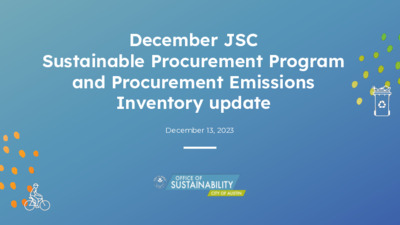1. Sustainable Procurement Update — original pdf
Backup

December JSC Sustainable Procurement Program and Procurement Emissions Inventory update December 13, 2023 Sustainable Procurement Program ○ Past- Timeline ○ Present- Program development supported by SPLC ○ Future- Next Steps Sustainable Procurement Initiatives 2004 Air Quality Improvement Through contracting preference 2005 United Nations Urban Environmental Accords Zero Waste by 2040 2007 Carbon Neutrality Plan, Sustainability Standards in Municipal Projects 2008 Responsible (Green) Purchasing Program initiated ; Resolution to Eliminate Purchasing of Plastic Bottles 2014-2017 Internal training materials developed 2018 Sustainable Procurement Program policy vision text developed 2020 Climate Equity Plan goals adopted 2022 Baseline Procurement Emission Inventory Year w/ Parametrix 2023 SPLC Sustainable Procurement Program support Sustainable Procurement Leadership Council Coaching SP Program Components 🗸 - Vision 𐄂 - Program Charter 𐄂 - Establishing Goals and Metrics 𐄂 - Strategy Development 𐄂 - Staff Engagement and Accountability Vision We envision a future where every purchase we make is a statement of our commitment to sustainability, fostering a balance between people, planet, and prosperity. By choosing climate-friendly, environmentally preferred and ethically-sourced products, and investing in small businesses, we strive to create a positive impact on the environment, communities, and future generations. Strengthening the City’s sustainable procurement program A program charter defines the ways in which our program will work toward the vision and includes: 𐄂 Program objectives 𐄂 Program and Resource Commitments 𐄂 Program Structure 𐄂 Prioritization 𐄂 Focus Areas 𐄂 Metrics for Success 𐄂 Continuous Improvements Next Steps: Continue sustainable procurement program coaching with SPLC Plan to spend 2023-2024 budgeted $100K on sustainable procurement program development and climate plan implementation Goal 2 Strategies #1-2 Sustainable Procurement Program Focus Area Update: Procurement Emissions and Impacts ○ Procurement Inventory Intro ○ Preliminary Results ○ Next Steps Climate plan and Procurement Food and Product Consumption Goals Goal 2: By 2030, reduce greenhouse gas emissions from institutional, commercial, and government purchasing by at least 50%. 1. Measure institutional lifecycle emissions • Develop a methodology to measure lifecycle greenhouse gas emissions and other environmental and social impacts from non-residential purchasing and identify a baseline for progress 2. Strengthen the City’s sustainable purchasing program programs 3. Strengthen non-City institutional purchasing 4. Expand the City’s Circular Economy Program Climate plan and Procurement Food and Product Consumption Goals Goal 2: By 2030, reduce greenhouse gas emissions from institutional, commercial, and government purchasing by at least 50%. 1. Measure institutional lifecycle emissions • Develop a methodology to measure lifecycle greenhouse gas emissions and other environmental and social impacts from non-residential purchasing and identify a baseline for progress 2. Strengthen the City’s sustainable purchasing program programs 3. Strengthen non-City institutional purchasing 4. Expand the City’s Circular Economy Program Carbon Emission “Scopes” City of Austin Municipal Footprint Scopes 1 and 2 Methodology characteristics • Developed from universally accepted guidance • Spend-based methodology uses basic industry-wide emissions factors to estimate emissions, and does does not consider Austin’s spending commitments or use EPDs or vendor provided emissions factors Emissions and Impacts from Purchasing, inventory process: Analysis for action planning and prioritization Develop purchasing emissions reduction (CO2/$) strategies Basic accounting for first/baseline year; Follow-up inventory Implement and monitor Emissions and Impacts from Purchasing, inventory process: S T L U S E F R A R D Basic accounting for first/baseline year; Follow-up inventory Analysis for action planning and prioritization Develop purchasing emissions reduction (CO2/$) strategies Implement and monitor Spending by Category- Draft Human Respiratory Impacts - Draft Overall HRSP impacts from 2022 City of Austin purchasing was 223,000 kg PM2.5e. ETOX intensity - Draft Water use Intensity - Draft Energy Impacts- Draft Emissions by Spending category - Draft Emissions by Spending Category 2022 Procurement emissions: 206,000 MT CO2e Impact intensities by Spend Category - Draft High Intensity Products Half of the highest intensity commodities are related to construction, and construction has the highest impact in terms of total City spend. Top vendors Spend x Industry-wide Emissions factor = Emissions $ x eCo2/$ = eCo2 The top 20 “Tier 1” vendors for the City of Austin procurement in 2022 represent nearly 40% of procurement spending in 2022, and nearly 53% of emissions Top vendor types: 1. 2. 3. 4. 5. 6. 7. “Construction” “Tech” Utilities “Concrete” “Concrete” “Construction” “Construction” “Petroleum” Next Steps: Identify potential actions to reduce procurement emissions Study recommendations on prioritized spending categories and Study recommendations on prioritized vendors, their contracts products Prepare to: Document and monitor progress through future inventory estimates, Share process with relevant stakeholders Addendum slides Emissions breakdown for Construction and Maintenance Rough emissions breakdown for Road Construction Concrete emissions breakdown